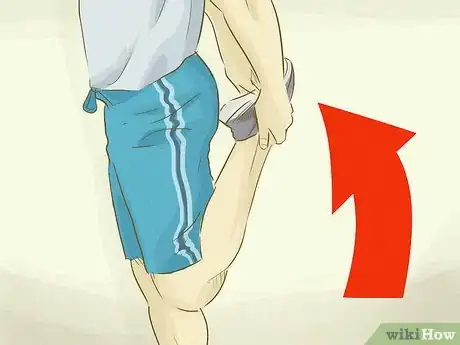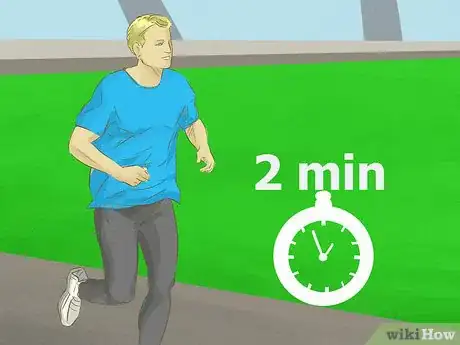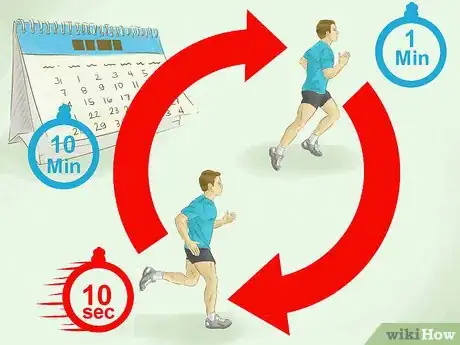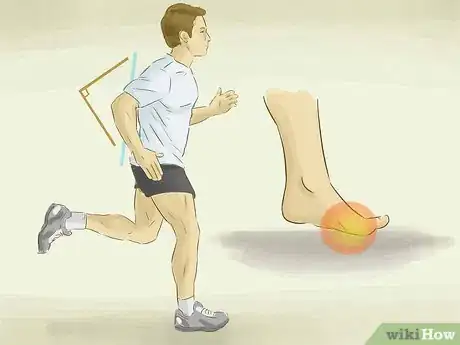This article was co-authored by Francisco Gomez. Francisco Gomez is the Head Coach at the FIT Potato Gym, a training gym established in 2001 in the San Francisco Bay Area. Francisco is a former competitive runner who helps endurance athletes train for major marathons like the Boston Marathon. Francisco specializes in Injury Rehab, Flexibility, Marathon Training, and Senior Fitness. He has a B.S. in Nutrition and Exercise Physiology & Running.
There are 7 references cited in this article, which can be found at the bottom of the page.
This article has been viewed 65,294 times.
There's no magic way to become a faster runner. You can't do it without consistent exercise, self-control, and attention to form. Luckily, a few simple tricks can make the path to faster running speed a little easier to navigate. By having a smart exercise routine and pushing yourself to run to the best of your ability, you can see improvements in as little as a few weeks.
Steps
Changing Your Routine
-
1Stretch before you run. Stretching is an important part of almost any exercise routine. Running is no exception. When you stretch, you're warming up the muscles in your body and getting them pumped up for the hard work that you're about to do.
- One good stretch is called "the Stork." Stand up straight. Bring one foot up behind you toward your bottom. Gently grab it with one hand (you can support yourself against a wall with your other hand if necessary). Put light tension on your leg until you feel a stretch in your quadriceps (the front of your thigh). Hold for 30 seconds, then repeat with the other leg.[1]
- Focus on stretching your hips, hamstrings, quads, and calves.[2]
-
2Give yourself a chance to warm up. Before you run, speed up your heartbeat and get your blood pumping by taking a two-minute jog. You'll get a slight boost of energy and it will be easier to focus on running quickly. As long as your warmup isn't too intense, you won't be too tired to give your run your best effort.Advertisement
-
3Practice consistently. For most runners, going on a run every day or every other day is best. The key here is consistency. To see long-term results, you need to stick to your exercise schedule and slowly ramp up the difficulty over time. If you quit or fail to challenge yourself, your performance may plateau or even decrease.[3]
-
4Use interval training to build speed and endurance. Take 10 minutes each day for an interval run. As you run, follow this pattern: sprint for 10 seconds, then rest by jogging for a minute. Repeat for 10 minutes.[4]
- To challenge yourself, every week add a few seconds to your sprinting time and shorten your breaks. Over time, you will be able to run faster and longer.
-
5Invite friends to run with you. Try competing with a friend slightly faster than yourself. It will give you the motivation of winning, and it will be much more challenging than running by yourself or with someone slower than you. Don't run with someone much faster than you, or you might consider giving up.
Changing the Way You Run
-
1Use good running form. Adopt a proper running posture, keeping your back straight and swaying your arms held in a 90-degree angle at the elbow. Run on the balls of your feet, using them to spring off with every step.[5]
- Try pushing your legs further back to give yourself a longer stride. You will get a better grip of the ground and allow yourself to bounce off the ground, and it gives you an extra boost in every step. If you ever watch Olympic sprinters, you'll notice that they almost always have very long strides.
- Your upper body is important too. Put a bend in your arms and pump them up and down sharply with each step. Leave your palms open, with fingers together as if you were stabbing the air. This should help you force yourself forward more easily.
-
2Use a sustainable breathing pattern. While you run, you want to be taking in enough oxygen that you can maintain a light conversation. If you can't, you're likely to run out of steam and you'll have to slow down. Deep, steady breathing will help you run more quickly in the long term.[6]
- Some people breathe in through their noses for three seconds and exhale for two. See what you're comfortable with — one person's breathing style may not be best for everyone.
-
3Give yourself a time goal. Use a stopwatch to time yourself every running session. Each time, try to go just a little bit faster on the same route. The added incentive will help you push yourself to the max.
- Just before you reach your goal, even if it seems impossible, try to force as much power out of your body as you can and put out a burst of speed. You may be surprised by how fast you can actually go when you know you're about to reach your goal. This can improve your time drastically.
-
4Keep your eyes on the prize (literally). Even something as simple as changing the way you look ahead can make you a better runner. Try to focus your eyes on where you want to go, rather than on the area right in front of your feet. Keep focusing on new spots further down the path as you move — you won't ever feel like you're almost done, so you won't give up as easily.
- For example, if you're running on a straight track and you're coming to the end, try focusing on a spot far ahead of the finish line and push yourself to run there. This can help keep your motivation high until it's actually time to quit.
-
5Hydrate! If you're not meeting your biological needs, you'll have a harder time running as fast as you can. Taking a small drink of water before your run ensures your muscles have the water they need when it counts. It's also a good idea to carry a little water with you so you can take drinks as needed during your run.[7]
- There is such a thing as too much water, however. Don't drink a ton of water right before running. Drink small amounts as you go, but try not to take big gulps. This will give you cramps.
Expert Q&A
-
QuestionWhat drills make you run faster?
 Francisco GomezFrancisco Gomez is the Head Coach at the FIT Potato Gym, a training gym established in 2001 in the San Francisco Bay Area. Francisco is a former competitive runner who helps endurance athletes train for major marathons like the Boston Marathon. Francisco specializes in Injury Rehab, Flexibility, Marathon Training, and Senior Fitness. He has a B.S. in Nutrition and Exercise Physiology & Running.
Francisco GomezFrancisco Gomez is the Head Coach at the FIT Potato Gym, a training gym established in 2001 in the San Francisco Bay Area. Francisco is a former competitive runner who helps endurance athletes train for major marathons like the Boston Marathon. Francisco specializes in Injury Rehab, Flexibility, Marathon Training, and Senior Fitness. He has a B.S. in Nutrition and Exercise Physiology & Running.
Athletic Trainer Try sprinting at the end of your run. Incorporate a few sprints just to wake up your motor skills. That will help you condition your spinal cord and the muscles you use to run, which will help you be faster during a race.
Try sprinting at the end of your run. Incorporate a few sprints just to wake up your motor skills. That will help you condition your spinal cord and the muscles you use to run, which will help you be faster during a race. -
QuestionHow do I not ever lose in a race?
 Community AnswerIf you never want to lose, then never compete. There will always be somebody faster than you. You will have off days and you aren't always going to be the best out there. The point of entering races is to give it your best and to outdo your last best. If you happen to win over the others as well, that is a fortunate bonus. Focus on the journey, not just the ends.
Community AnswerIf you never want to lose, then never compete. There will always be somebody faster than you. You will have off days and you aren't always going to be the best out there. The point of entering races is to give it your best and to outdo your last best. If you happen to win over the others as well, that is a fortunate bonus. Focus on the journey, not just the ends. -
QuestionHow do I win a race?
 Community AnswerPractice is key. You have to train prior to the race before competing. Try running a little more each day and time your progress. Don't forget to eat healthy and wear the appropriate clothing as well.
Community AnswerPractice is key. You have to train prior to the race before competing. Try running a little more each day and time your progress. Don't forget to eat healthy and wear the appropriate clothing as well.
Warnings
- Don't push yourself too hard to run faster. If you feel dizzy, short-of-breath, or light-headed, stop right away and take a rest.⧼thumbs_response⧽
References
- ↑ http://www.prevention.com/fitness/strength-training/stretching-101-moves-longer-leaner-body
- ↑ Francisco Gomez. Athletic Trainer. Expert Interview. 24 October 2019.
- ↑ https://trailrunnermag.com/training/training-plans/consistency-not-intensity-key-running-success.html
- ↑ https://www.ncbi.nlm.nih.gov/pubmed/29076961
- ↑ https://www.self.com/story/what-proper-running-form-actually-is
- ↑ https://runnersconnect.net/how-to-breathe-running/
- ↑ https://www.ncbi.nlm.nih.gov/pmc/articles/PMC2838466/
- ↑ Francisco Gomez. Athletic Trainer. Expert Interview. 24 October 2019.
About This Article
The best way to run faster is to build your speed and endurance through interval training. For example, sprint for 10 seconds, then rest by jogging for a minute, and repeat for 10 minutes. Challenge yourself by adding a few seconds to your sprinting time each week and shorten your breaks to get faster and longer over time. Additionally, make sure you use deep, steady breathing so that you’re taking in enough oxygen and stay hydrated when you run. For more advice, like how to use good running form, keep reading!




































































